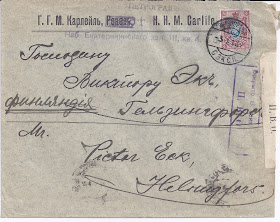After the overthrow of the Tsar, mail from Russia to Finland
continued normally. After Finland’s declaration of Independence in July 1917,
mail continues to be franked at the Domestic Tariffs in force under the Provisional
Government. There is normally NO Russian censorship applied to the outgoing
mail but normally there is Finnish censorship evidenced by typical oval cachets
in red, usually applied in Åbo. In my holding of 29 items of mail sent during the
period of the Provisional Government just one
has Russian censorship, applied at its starting point in Orenburg.
After the Bolshevik seizure of power, there is a
rapid change in the way mail is handled. The majority of mail now shows signs
of Russian censorship with letters actually being opened and re-sealed. At
the same time, the red oval Finnish censorship cachets disappear. In my sample
of 27 items sent after the Bolshevik seizure of power, 19 have Russian censorship indications including all the letters and just one has a
Finnish censorship mark and that is a new post-Independence mark.
This abrupt introduction of Russian censorship probably reflects the Soviet fear that
Finland would be used as a base for counter-revolutionary activity (as it was).
Mail continues to be franked at the domestic rates
except for two ordinary commercial letters sent in early 1918 from Petrograd
and Moscow, franked at the foreign rate of 20 kopecks.
The Bolsheviks had recognised
Finnish independence in December 1917 but this does not seem to have been routinely carried through into the Tariffs applied .
Some of the mail sent in the first few months of
Bolshevik power shows evidence from arrival cancels of long delays in delivery,
extending to months. This no doubt reflects the impact on the mail service of
Finland’s own Civil War.
Ordinary letter sent from PETROGRAD 18 8 17 during the period of the Provisional Government, franked at the Domestic tariff of 15 kopecks with oval red Finnish censorship cachet. No markings on the reverse
Ordinary letter sent from PETROGRAD 3 1 18 [Old Style] under the Bolsheviks, franked at the Domestic tariff of 15 kopecks with Petrograd paper censorship strip and boxed violet cachets. Received in Helsinki (roller cancel on reverse) 12 March 1918 [New Style]
Ordinary letter sent from PETROGRAD 14 1 18 [Old Style] under the Bolsheviks, franked at the Foreign letter tariff of 20 kopecks with Petrograd paper censorship strip and boxed violet cachet (on reverse). Received in Helsinki (roller cancel on reverse) 13 March 1918 [New Style]
Ordinary letter originating in Petrograd (sender's address on reverse), hammer and sickle seal used as cancel, Petrograd paper censorship strip and boxed violet cachet on reverse. Post- independence Finnish censorship on the front at bottom right. Franked at 70 kopecks probably representing a double weight Domestic letter sent in the Tariff period 28 February - 14 September 1918. Mss. POL[ucheno = Received] 27 OKT[ober] top left, confirmed on reverse by crayon 17 / 30 Oct marking - ie, Old Style 17 October, New Style 30 October.
Click on Images to Magnify
Added 30 September 2015: In relation to the cover above, Kaj Hellman draw my attention to this illustration in The Finnish Philatelist, November 2000. The seal used as a cancellation is, in effect, a censorship / control mark specific to mail going to Finland:
Click on Image to Magnify
Added 12 September 2015:
Kaj Hellman tells me that the Civil War in Finland is usually dated as beginning 27 January and ending 15 May 1918. During this period, mail from Bolshevik Russia travelled only to Red controlled areas in the south of Finland ( Helsinki, Turku, Wiborg etc).
Mail later in 1918 is very scarce. It includes the last item shown above which has been censored at RAJAJOKI with a # 1 Censor mark. Other numbers exist but the mark is rare - Kaj Hellman says he has seen 4 or 5 examples [ to which I add: in his long career as Finland's leading specialist stamp dealer and auctioneer].
Rajajoki was on the old (pre-1940) river border between Finland and Russia. It is now Sestra in Russia. The censor mark reads at top line TARKASTETTU (Inspected), then RAJAJOEN (Rajajoki's), then P:nä (Day) and ... Kuuta (Month) which have not been filled in on this example Finally, at the bottom there is "No. 1"
Added 20 September 2015: Alexander Epstein provides this very nice cover from Kislovodsk to Hanko. I think it is a double weighted Registered letter (35 +35 postage + 70 kop Registration), routed via Petrograd censors. The important things are the dates: sent 29 3 18, arrived .. X 18 (receiver cancel on reverse)
Click on Images to Enlarge







No comments:
Post a Comment